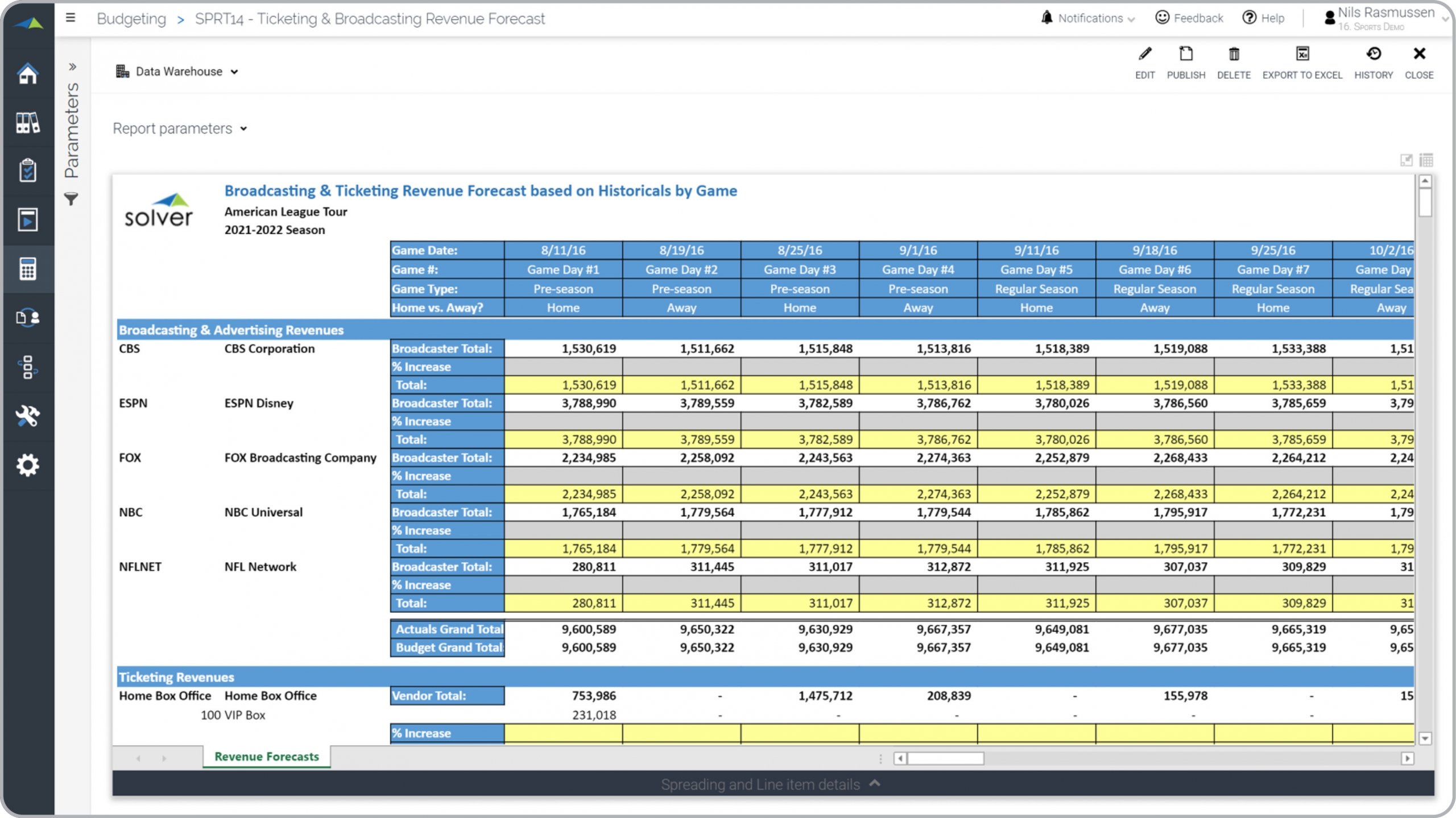Media and Ticket Revenue Forecast for Professional Sports Teams
What is a
Media and Ticket Revenue Forecast
? Broadcasting and ticketing budgets and forecasts are considered revenue planning tools and are used by budgeting managers to create detailed bottom-up revenue estimates. Some of the main functionality in this type of input model is that it displays historical game and media metrics that users can adjust to arrive at new budgets or forecasts. Pre-season, regular season and post season games are listed across the columns. The first input section is used to plan for broadcasting and advertising revenues while the second section (seen at the bottom of the screen) is used for ticketing revenue planning. You find an example of this type of input model below.
Purpose of
Media and Ticket Revenue Models Sports organizations use Media and Ticket Revenue Models to make as automated and detailed budgets and forecasts as possible using historical metrics as a baseline. When used as part of good business practices in Financial Planning & Analysis (FP&A) departments, a company can improve its revenue planning accuracy and efficiency, and it can reduce the chances that users over- or under estimates figures due to lack of easily available data.
Example of a
Media and Ticket Revenue Model Here is an example of a media and ticketing revenue budget form with input per game. [caption id="" align="alignnone" width="2560"]
 Example of a Media and Ticket Revenue Forecast for Professional Sports Teams[/caption] You can find hundreds of additional examples
here
Who Uses This Type of
Input model
? The typical users of this type of input model are: CFOs, media and ticket managers, budgeting managers.
Other Reports Often Used in Conjunction with
Media and Ticket Revenue Models Progressive Financial Planning & Analysis (FP&A) departments sometimes use several different Media and Ticket Revenue Models, along with profit & loss reports, detailed ticket and media reports, revenue dashboards, complete financial budget and forecast models and other management and control tools.
Where Does the Data for Analysis Originate From? The Actual (historical transactions) data typically comes from enterprise resource planning (ERP) systems like: Microsoft Dynamics 365 (D365) Finance, Microsoft Dynamics 365 Business Central (D365 BC), Microsoft Dynamics AX, Microsoft Dynamics NAV, Microsoft Dynamics GP, Microsoft Dynamics SL, Sage Intacct, Sage 100, Sage 300, Sage 500, Sage X3, SAP Business One, SAP ByDesign, Acumatica, Netsuite and others. In analyses where budgets or forecasts are used, the planning data most often originates from in-house Excel spreadsheet models or from professional corporate performance management (CPM/EPM) solutions.
What Tools are Typically used for Reporting, Planning and Dashboards? Examples of business software used with the data and ERPs mentioned above are:
Example of a Media and Ticket Revenue Forecast for Professional Sports Teams[/caption] You can find hundreds of additional examples
here
Who Uses This Type of
Input model
? The typical users of this type of input model are: CFOs, media and ticket managers, budgeting managers.
Other Reports Often Used in Conjunction with
Media and Ticket Revenue Models Progressive Financial Planning & Analysis (FP&A) departments sometimes use several different Media and Ticket Revenue Models, along with profit & loss reports, detailed ticket and media reports, revenue dashboards, complete financial budget and forecast models and other management and control tools.
Where Does the Data for Analysis Originate From? The Actual (historical transactions) data typically comes from enterprise resource planning (ERP) systems like: Microsoft Dynamics 365 (D365) Finance, Microsoft Dynamics 365 Business Central (D365 BC), Microsoft Dynamics AX, Microsoft Dynamics NAV, Microsoft Dynamics GP, Microsoft Dynamics SL, Sage Intacct, Sage 100, Sage 300, Sage 500, Sage X3, SAP Business One, SAP ByDesign, Acumatica, Netsuite and others. In analyses where budgets or forecasts are used, the planning data most often originates from in-house Excel spreadsheet models or from professional corporate performance management (CPM/EPM) solutions.
What Tools are Typically used for Reporting, Planning and Dashboards? Examples of business software used with the data and ERPs mentioned above are:
- Native ERP report writers and query tools
- Spreadsheets (for example Microsoft Excel)
- Corporate Performance Management (CPM) tools (for example Solver)
- Dashboards (for example Microsoft Power BI and Tableau)
Corporate Performance Management (CPM) Cloud Solutions and More Examples
June 14, 2021
TAGS:
Reporting,
Solver,
NPSL,
report writer,
Microsoft,
NBA,
template,
practice,
Acumatica,
basketball,
league,
MLB,
Netsuite,
Finance,
planning,
GP,
Business Central,
excel,
professional,
ax,
Sports,
forecast,
Budget,
Dynamics 365,
budgeting,
professional sports,
Cloud,
Software,
Tableau,
SAP,
NRL,
example,
NHL,
NFL,
media,
best,
Sage,
BC,
EPL,
D365,
MLS,
NAV,
Intacct,
soccer,
broadcast,
hockey,
baseball,
CPM,
report,
SL,
Management,
dynamics,
football,
Power BI,
game,
media revenue budget,
media revenue forecast

